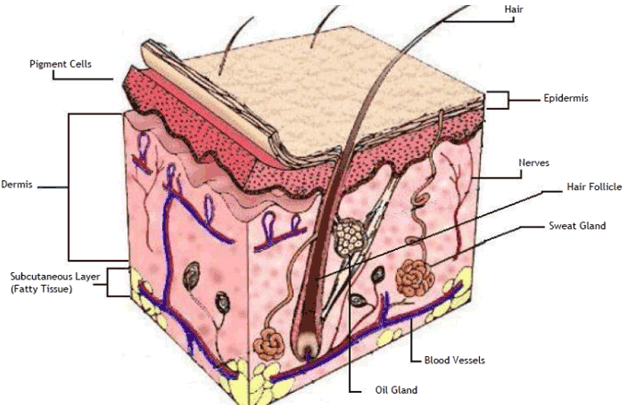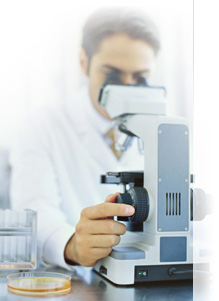Healthy Skin
Skin Protects Us
The skin, along with hair and nails, is the protective covering of the body. In addition, the skin prevents germs from entering the body and damaging internal organs. Skin supports the life of all other body parts and plays a role in maintaining the immune system.
Skin also helps to regulate body temperature through the sweat glands. When the body becomes overheated, sweat glands give off moisture (perspiration), which cools the body as it evaporates. As the body part responsible for the sense of touch, the skin works with the nervous system to alert the body to potential dangers by detecting pressure, pain, heat, and cold.
When exposed to the sun's ultraviolet rays, the skin manufactures Vitamin D, an essential vitamin for healthy skin. Vitamin D promotes the body's absorption of calcium, which is essential for the normal development of healthy teeth and bones.
Skin: The Body's Largest Organ
Skin is the largest organ of the body. It consists of three layers of tissues: the epidermis, the dermis and the subcutaneous layer. The epidermis is the paper-thin outer layer of the skin. The outer layer of the epidermis consists of dead cells that are always flaking or washing off. These are replaced by new cells manufactured in the lower portion of the epidermis, which move upward to the outside of the skin. As they do so, the cells harden and die. This cycle of cell production and replacement takes about 28 days.

The structure of skin
The epidermis also contains melanocytes, the cells that contain melanin — the pigment that gives skin its color. Skin color is determined by the amount of melanin in these cells, not cell number. The more melanin, the darker the skin.
The dermis, the middle layer of the skin, contains blood vessels, nerves, hair follicles, sweat glands and oil glands. It makes up about 90 percent of the skin's thickness and is made up of collagen and elastic fibers that give the skin strength and elasticity.
The subcutaneous layer, the deepest layer of skin, is mostly composed of fatty tissue. It also contains blood vessels and nerves. The fat insulates the body from extreme heat and cold and provides a cushion to protect the body from injuries.
Hair & Nails Protect Us, Too
Hair and nails also protect the body. Hair keeps the head warm, while eyebrows and eyelashes protect the eyes from direct light. Hair also serves as a barrier to keep dirt from entering the eyes and nose. It is made up of keratin, a type of non-living protein made by living skin cells. Hair grows out from hair follicles.
Nails are protective structures made of hard keratin, a type of non-living protein made by living skin cells. Their job is to protect the sensitive area of the toes and fingers and to give the fingers and hands a grasping function. Nail cells form at the base of the nail in an area called the nail matrix (the lighter "half moon" on our fingernails).
The Importance of Making Healthy Choices
Your skin reveals to the world how healthy you are - and how old you are. Positive lifestyle behaviors keep you healthy and your skin looking younger. The following lifestyle behaviors can impact the skin:
|
Alcohol Body Piercing Exercise Hair Products Hygiene |
Nails & Manicures Nutrition & Water Perspiration Seeing Your Dermatologist Smoking |
Stress Sun Safety & Indoor Tanning Tattoos |
Alcohol
Drinking alcohol enlarges a person's blood vessels, which can temporarily redden or flush the cheeks. When blood vessels are severely damaged by chronic drinking, the palms and soles also become reddened.
Chronic drinkers develop larger oil glands and blood vessels. This process results in the enlargement of the skin's pores, particularly of the nose and chin. Chronic drinking can cause liver disease, including cirrhosis, which changes the skin color to yellow.
Body Piercing
Much of the same advice about tattooing applies to body piercing. Infection is possible if the piercer does not follow proper health procedures, such as washing hands, wearing gloves, disinfecting surfaces, and using a new sterile needle. Infection is also possible if the individual does not care for the hole properly. About 15% of the population is allergic to nickel, a material common in body jewelry. These people may experience rashes as a result of exposure to the metal.
Depending on where jewelry is placed, body piercings can cause problems with speech, eating, hearing and other body functions. For example, body jewelry can be torn out during contact sports. Dentists are particularly concerned about the dangers of tongue piercings. Among the things that can go wrong as a result of tongue piercings are swelling of the tongue that can interfere with breathing, cracked teeth, choking on loosened or unscrewed jewelry, and infection with hepatitis, HIV or bacteria.
Exercise
Exercise contributes to weight maintenance, which helps maintain the smooth appearance of the skin. However, some forms of exercise can also damage the skin. For example, weightlifting to increase muscle size can produce "stretch marks" because of breaks within the connective tissue of the dermis. When a person loses weight too rapidly, his or her existing stretch marks will grow.
Exercise also increases sweating and skin temperature. Infections caused by bacteria and/or fungi may occur if proper hygiene is not performed after exercise. In addition, some clothes and shoes used while exercising can lead to blisters on the hands, feet or body.
Hair Products
Some hair dyes can cause allergic reactions. Be sure to test the dye on a small area of your skin (behind the ear or inside the elbow) and wait 48-72 hours before making a change in your hair color with these products.
Permanent waves can damage the hair, so take care not to perm your hair more often than every three months. If the perming solution is left on too long, is too strong or is applied to hair already damaged by dyes, the hair could break and the scalp could become irritated. Frequent tight braiding or tight ponytails, as well as hair straightening agents, flat irons, curling irons, and hot rollers, can also cause hair loss or broken hair.
Hygiene
Hygiene impacts the health of the skin. A basic hygiene routine includes washing the face in the morning and before bed with soap/cleanser, warm water and a clean wash cloth, taking a shower or bath daily using warm water, soap and a clean wash cloth, cleaning nails, and washing hair regularly (e.g., every 2-3 days).
Nails & Manicures
If you manicure your own nails, be careful not to cut, remove or injure nail cuticles. Their job is to prevent infection and protect nail-forming cells.
Nail polish and nail glue can cause allergic reactions. Use a polish that is labeled "hypoallergenic" and nail polish remover that is acetone-free.
Sculptured nails - those that are custom-made to fit permanently over your natural nails - can cause severe and painful reactions. Doctors recommend that people who wear artificial nails take them off every three months to allow their natural nails to breathe.
Nutrition & Water
Eating a well-balanced diet helps insure that your body gets all the vitamins it needs to maintain healthy skin. The following nutrients help the life of your skin:
- Vitamin A - Helps maintain healthy, smooth skin and hair
- Riboflavin (B1) - Helps prevent skin disorders, especially around the nose, lips and mouth
- Niacin (B3) - Helps prevent skin disorders, especially on parts of the body exposed to the sun
- Vitamin B6 - Helps prevent skin disorders and cracks around the mouth
- Vitamin C - Helps in healing of skin
- Vitamin D - Helps keep skin healthy. (This "sunshine vitamin" is also manufactured by the skin with the help of sunlight.)
- Water is the most important nutrient we consume. The human body is anywhere from 55 to 75 percent water. Without water, we could not survive. It is recommended that people drink 8 glasses of water a day.
Perspiration
Through the skin's process of sweating, the water we drink helps to cool our bodies in warm weather. When the body gets too warm, water seeps out through the sweat pores of the skin. Sweat evaporates from our skin using heat from the body to turn the liquid into vapor. It is harder for the sweat to evaporate quickly on a humid day, which is why we feel warmer than we do on a dry day at the same temperature.
Smoking
Smokers have more wrinkles around their eyes and mouths, especially since they're continually tightening their lips around cigarettes. Tobacco and cigarettes can cause the skin to turn an unhealthy, unnatural color.
Smoking and chewing tobacco can also hurt the skin through the development of lip cancer, mouth cancer and/or emphysema. When emphysema in the lungs causes shortness of breath, the skin may turn bluer due to lack of oxygen.
Stress
Stress plays a role in skin care, especially because many habits associated with stress hurt the skin. For example, lip biting can tear and damage skin. Rubbing and scratching the skin can cause a skin condition called dermatitis. Picking at the cuticle skin around your nails can also produce infection. Additionally, if you shower with very hot water to relieve stress, your skin may become dry and itchy. Stress can also play a role in the development of various skin ailments.
Sun Safety & Indoor Tanning
Limiting your exposure to ultraviolet (UV) radiation while protecting your skin is the single most important thing you can do to maintain healthy skin. Please click here to visit our Sun Safety & Indoor Tanning page.
Tattoos
Tattooing has been performed as a decorative art form since ancient times. Today, it is growing in popularity and is also being used as a form of permanent make-up.
Tattooing involves injecting dyes into the skin with multiple injections from one or more needles. It can take several hours to complete a tattoo and the procedure may be painful. It may also cause some bleeding. It takes about 7 to 10 days for the tattoo to heal.
Tattooing received a bad reputation in the past due to tattoo artists who neglected health and safety concerns. This resulted in outbreaks of infectious diseases and banning of the practice in some states and localities.
The two biggest risks in getting a tattoo are allergic responses to the dyes and exposure to bloodborne pathogens. The dyes are made from chemical compounds ranging from metal oxides to synthetic organic dyes. The most common infectious diseases associated with tattoos are atypical mycobacteria and hepatitis B, although hepatitis C and HIV are also possible. Proper disinfection and sterilization procedures must be followed. Someone thinking of getting a tattoo should check with the state or local health department to see which regulations exist in the area, such as a requirement that only new sterile needles be used. Also, check to see if the tattooist has been certified by the Alliance for Professional Tattooists.
Dermatologists report that over 50% of the people who get tattoos eventually seek to have them removed, usually after they have entered the work world. Although tattoos can be removed, the process is very expensive and painful. It may take several months and could result in scarring.
Seeing Your Dermatologist
We've seen that our skin is our body's largest organ. Our skin works 24/7 to take care of us, protect us, and keep us healthy. And we have a responsibility to take care of our skin. One of the best ways to accomplish this is to schedule regular visits with a medical skin care expert - your local dermatologist. Your dermatologist has the training and expertise to help keep your skin healthy throughout your life.
To find a dermatologist in your area, please visit American Academy of Dermatology's "Find a Dermatologist".




